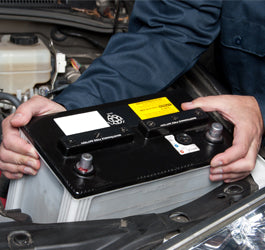
Anyone into leisure rides such as RVs, 4WDs, and boats would have heard about dual battery systems. This setup is used for travelling outdoors mainly because it provides ample power to run your electronics without the risk of draining your starter battery.
A dual battery system includes a main battery for your engine and a secondary battery for powering your accessories. These two power packs function as isolated systems. It means that when your vehicle runs, your starter battery works with your alternator to run your ride and its electronics. On the other hand, when your vehicle is turned off, your auxiliary battery works to power all other essentials in it such as lights and portable appliances.
This independent process of both batteries is made possible through the isolator, which helps disconnect the two to ensure you only draw power from one battery at a time and avoid draining any of your power sources.
In a dual battery setup, your secondary battery would most likely be a deep cycle battery too. Deep cell batteries are known for having a higher efficiency rating than conventional batteries, which also translates to longer run times. It's your best pick for any outdoor adventure, especially ones where you travel to different places from time to time.
How To Install A Dual Battery System?
Setting up dual batteries for your vehicle can be done with the help of a professional or by yourself alone, provided that you have the necessary experience and basic knowledge of handling batteries.
Below is a step-by-step process if you're looking to install your own dual battery system:
Step 1
Mount the auxiliary battery on your rig and ensure you have enough wire for the necessary connections. After this, disconnect your main battery.
Step 2
Set up your Voltage Sensitive Relay (VSR). Place it as close as possible to your main battery and away from any hot parts.
Step 3
Cut your cables accordingly and fit lugs on their bare ends. Do this by stripping away 15mm of insulation and crimping them before applying heat (from heat shrink) to seal.
Step 4
Earth the relay using the black wire attached to the VSR and connect it to your main battery.
Step 5
Earth your second battery and place your VSR on the mounting plate. Attach the negative leads to your starter battery and then to your second battery.
Step 6
Use a multimeter to test if your system is working.
Deep Cycle Batteries As Auxiliary Batteries
As mentioned earlier, deep cycle batteries make superior secondary batteries. This is especially true for lithium deep cycle batteries such as LiFePO4, as they fuse the benefits of a longer run time and highly-efficient performance.
A lithium-based deep cycle battery will give you an extended service life that is twice or sometimes even thrice the lifespan of a lead-acid battery. LiFePO4 power packs in particular are also extremely safe with a non-toxic composition and incombustible form.
These power packs can be more expensive than conventional lead-acid or AGM deep cycle batteries but have been proven to be a more cost-effective long-term choice for leisure vehicle owners. For one, the quality is unrivalled and you can get the most out of its longer lifespan with regular maintenance.
If you're after quality LiFePO4 batteries to use as a secondary boat battery, caravan battery, or 4WD battery, visit us at Outbax for a variety of options. We have standard 12V 100Ah lithium batteries, 24V batteries and even the famous slimline lithium batteries for those looking to save space in here!



